TEXAS -- It’s not flash floods, tornadoes or even hurricanes. The number one weather-related killer is heat, and the heat is on in Central Texas.
Record temperatures are anticipated in South Central Texas this week.
This puts us in dangerous heat territory, and it’s strongly recommended you avoid outdoor activities. However, if you must be outside or your home lacks air conditioning, there are a number of warning signs for heat-related illness you need to be aware of. Heat-related illness is preventable, and these steps could save your life or the life of a loved one.
Heat Stroke
According to the Centers for Disease Control and Prevention, the warning signs for heat stroke include a body temperature of 103 or higher, confusion, loss of consciousness, headache, nausea, dizziness, headache, a fast, strong pulse, and hot, red, damp or dry skin.
If you or someone you know is experiencing one or more of these symptoms in extreme heat, call 911 immediately. Heat stroke is a medical emergency. Also, move the person to a cooler place and bring his or her temperature down with cool cloths or a cool bath. It may strike you as odd, but the CDC says do not give the person anything to drink.
Heat Exhaustion
Signs of heat exhaustion include heavy sweating, cold, pale and clammy skin, a fast or weak pulse, nausea or vomiting, muscle cramps, tiredness or weakness, headache, dizziness and fainting.
If you suspect someone is experiencing heat exhaustion, move that person to a cool place and loosen his or her clothes. Apply a cool, wet cloth and sip water. If the person is vomiting or if symptoms worsen or last longer than an hour, obtain medical aid.
Heat Cramps
Heat cramps can occur when exercising or undergoing strenuous work in extreme heat. Symptoms include heavy sweating, muscle pain or spasms.
If you experience these symptoms, immediately cease physical activity and move to a cool place. Trying drinking water or a sports drink and don’t engage in physical activity again until the cramps pass.
Obtain medical help if cramps persist for more than an hour, you’re on a low-sodium diet when symptoms appear or you have heart problems.
Sunburn
You’ve probably experienced this at least once, but symptoms include red, painful and warm skin. You also may experience blistering.
The CDC advises you stay out of the sun until the burn completely disappears. It’s also advised you put cool clothes on over affected areas or take a cool bath. You may apply moisturizing lotion to the burned area. Do not break blisters.
Heat Rash
Heat rash presents as a small cluster of blisters that resemble pimples on the skin, typically on the neck, chest, groin, or in the elbow creases.
It’s advised you remain in a cool place when dealing with heat rash and keep the rash dry. You may use baby powder to soothe the rash.



